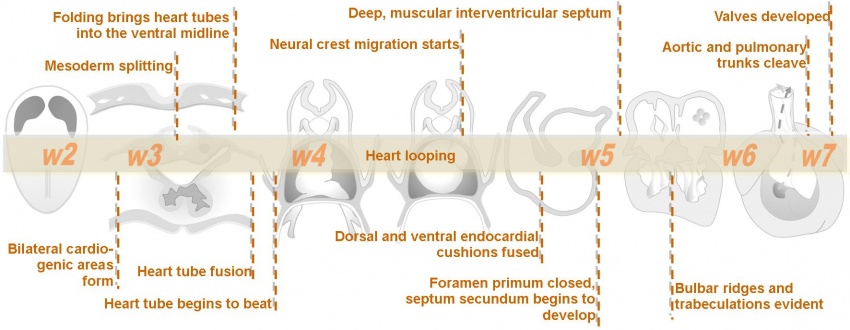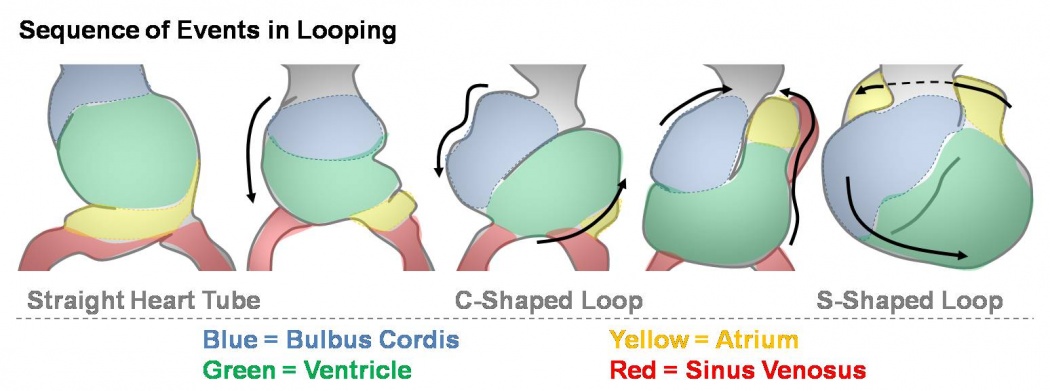Intermediate - Heart Tube Looping
| Begin Intermediate: | Primordial Heart Tube | Heart Tube Looping | Atrial Ventricular Septation | Outflow Tract | Heart Valves | Cardiac Abnormalities | Vascular Overview |
| Cardiac Embryology | Begin Basic | Begin Intermediate | Begin Advanced |
Looping of the heart tube allows the straight heart tube to form a more complex structure reminiscent of the adult heart. Most cardiac looping occurs during the fourth week and completes during the fifth week of development. The steps in looping can be summarised as:
- The straight heart tube begins to elongate with simultaneous growth in the bulbus cordis and primitive ventricle.
- This forces the heart to bend ventrally and rotate to the right, forming a C-shaped loop with convex side situated on the right.
- The ventricular bend moves caudally and the distance between the outflow and inflow tracts diminishes.
- The atrial and outflow poles converge and myocardial cells are added, forming the truncus arteriosus.
Hence an S-shape is formed with the first bend of the 'S' being the large ventricular bend while the bend at the junction of the atrium and sinus venosus forms the second 'S' bend.
The following animation portrays these concepts from the traditional, ventral view of the heart. You can also view this animation from a lateral left or right view.
<html5media height="560" width="720">File:Heart looping 002.mp4</html5media>
Throughout the morphological changes of the heart tube during looping, the locations of the divisions of the heart tube change, as described above.
The following scanning electron micrographs illustrate the same morphological changes in the heart tube described above. The straight heart tube can be seen to form a C-shape, with the convex bulge on the right side of the embryo representing much of the expansive conotruncus and right ventricle. By day 25 it is possible to see the early formation of the S-shaped loop where the left-sided predominant bulge indicates the left ventricle and the atrium and sinus venosus have moved dorsally.
Note that previously the heart was attached to the dorsal pericardial wall by the dorsal mesocardium. During heart looping, the dorsal mesocardium degenerates, forming the transverse pericardial sinus (a point of communication across the pericardial coelom).
| Back to the Primordial Heart Tube | Next: Heart Septation | |
| Go to this section in the basic level | Go to this section in the advanced level |
Glossary Links
- Glossary: A | B | C | D | E | F | G | H | I | J | K | L | M | N | O | P | Q | R | S | T | U | V | W | X | Y | Z | Numbers | Symbols | Term Link
Bulbus cordis: A region of the early developing heart tube forming the common outflow tract, will differentiate to form three regions of the heart.
Dorsal mesocardium: The mesentery attaching the heart to the dorsal wall of the pericardial coelom. This breaks down to form a space known as the transverse pericardial sinus.
Inflow tract: Entrance of blood into the heart tube; the sinus venosus portion of the tube.
Outflow tract: Exit of blood from the heart tube formed by the truncus arteriosus.
Primordial atrium: Common cavity in the upper portion of the developing heart. Later divides to form the left and right atria.
Primordial ventricle: Common cavity in the lower portion of the developing heart. Later divides to form the left and right ventricles.
Sinus venosus: An early developmental cardiovascular structure, thin walled cavity, forming the input to developing heart which has 3 venous inputs (vitelline vein, umbilical vein, common cardinal vein). Later in heart development this structure gets incorporated into the wall of the future right atrium.
Transverse pericardial sinus: Dorsal area within the pericardial coelom, initially occupied by the dorsal mesocardium.
Truncus arteriosus: An embryological heart outflow structure, that forms in early cardiac development and will later divides into the pulmonary artery and aorta. Term is also used clinically to describe the malformation of the cardiac outflow pattern, where only one artery arises from the heart and forms the aorta and pulmonary artery.


